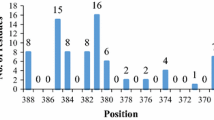Abstract
We have used second-order orthogonal designs to obtain empirical models that describe the combined effect of pH and temperature on the secondary structure of a lipase (Lip1) from Candida rusosa. The equations that describe lipase conformational flexibility were derivated from the enzyme alpha helix fraction obtained from the experimental matrix. The thermal unfolding of lipase at different pH values was followed by measuring the circular dichroism signal as a function of temperature over a temperature range of 20–80 °C. The results showed a melting temperature of 58.9 °C at pH 5.5, while at pHs 7.0 and 8.6, the temperature values were 50.2 °C and 36.1 °C respectively. The optimum experimental conditions of conformations with high content of alpha helix were found at high temperature and pH, both at zero time and at one-hour incubation time of enzyme. Important variations in the enzyme secondary structure were induced for the pH and temperature. In contrast, minor changes were observed during the incubation time. This behaviour suggests that the medium pH induces a modification in the enzyme secondary structure and not due to a result of a progressive denaturation process. From the values of thermodynamic functions at different pHs, the system at initial state of unfolding process is previously disordered by the pH effect.






Similar content being viewed by others
Abbreviations
- Lip1:
-
Candida rugosa lipase
- CD:
-
Circular dichroims
- Trp:
-
Tryptophan
References
Alonso DVO, Dill KA (1991) Biochemistry 30:5974–5979
Ankenman BE (2003) Transactions 35:493–502
Dill KA, Alonso DVO, Hutchinson K (1989) Biochemistry 28:5439–5447
Farruggia B, Rodriguez F, Rigattuso R, Fidelio G, Pico G (2001) J Protein Chem 20:81–89
Grochulski P, Li Y, Schrag JD, Bouthillier F, Smith P, Harrison D, Rubin B, Cygler M (1993) J Biol Chem 268:12843–12847
Grochulski P, Li Y, Schrag JD, Cygler M (1994) Protein Sci 3:82–91
Lakowicz JR (1983) Principles of fluorescence spectroscopy. Plenum Press (ed) New York
Lopez N, Pernas MA, Pastrana ML, Sanchez A, Valero F, Rua ML (2004) Biotechnol Prog 20:65–73
Mancheno JM, Pernas MA, Martınez MJ, Ochoa J, Rua ML, Hermoso JA (2003) J Mol Biol 332:1059–1063
Pernas MA, Lopez C, Rúa ML, Hermoso J (2001) FEBS Lett 501:87–91
Pernas M, Lopez C, Prada A, Hermoso J, Rua ML (2002) Col Surfaces B: Biointerfaces 26:67–75
Spelzini D, Farruggia B, Picó G (2005) J Chromatogra B 821:60–66
Stobiecka AJ (2005) Photochem Photobiol B: Biol 80:9–18
Acknowledgments
This work was supported by a grant from FonCyT n 508/06, PIP 00196/09-011 CONICET and European Community. P.F. is a fellowship from Alfa programme from European Community. We thank Marcela Culasso, María Robson, Mariana de Sanctis and Geraldin Raimundo for the language correction of the manuscript.
Author information
Authors and Affiliations
Corresponding author
Rights and permissions
About this article
Cite this article
Fuciños González, J.P., Bassani, G., Farruggia, B. et al. Conformational Flexibility of Lipase Lip1 from Candida Rugosa Studied by Electronic Spectroscopies and Thermodynamic Approaches. Protein J 30, 77–83 (2011). https://doi.org/10.1007/s10930-011-9313-5
Published:
Issue Date:
DOI: https://doi.org/10.1007/s10930-011-9313-5




